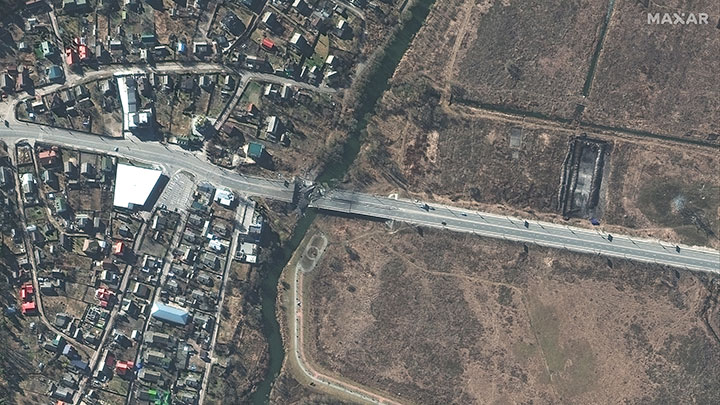 An image released by Maxar Technologies from its WorldView-3 satellite of a damaged bridge and road on the approach toward Kyiv, Ukraine, Feb. 27, 2022. (Source: Maxar)
An image released by Maxar Technologies from its WorldView-3 satellite of a damaged bridge and road on the approach toward Kyiv, Ukraine, Feb. 27, 2022. (Source: Maxar)
Constellations spoke with David Gauthier of GXO, Inc, about how the Department of Defense is procuring and using commercial data, technology and infrastructure.
Gauthier previously led Commercial and Business Operations at the National Geospatial-Intelligence Agency (NGA) before transitioning to Chief Strategy Officer of GXO, Inc., where he advises companies in the space and defense communities. The discussion covered how the Department of Defense acquires commercial data and emerging government efforts to expand public-private partnerships.
Pivoting DoD to Commercial-First Data Collection
In the past, commercial data has played a supporting role for the DoD. But with conflicts like the Russia-Ukraine war, there are increasing use cases to leverage the available data. “This is the first conflict, the Russia-Ukraine conflict, where commercial ISR and imagery [have] a leading role, and I think they’re winning the Oscar this year,” Gauthier says, adding that, “commercial data [will be] providing a critical advantage for strategic competition.”
Many in private industry have wondered if the federal government adequately values commercial data and imagery. Gauthier pushed back against this idea, stating that “it may have appeared that the government questioned the value of commercial imagery, but in reality, I think the value was well known, and the real limitation is where the government was willing to employ commercial imagery in its mission use.”
The largest challenge, Gauthier believes, is changing the existing culture to commercial-first data collection. “The established capabilities inside the government have been there for decades… to go in and modify that for commercial-first operating concept is very difficult,” he says. “Demand lags new capability by a couple of years,” Gauthier says, explaining that U.S. federal budgeting happens two years in advance. A “four-to-five-year lag in adoption and budgeting [is] just sort of built into the system that we operate with.”
Commercial Data and the Russia-Ukraine War
In the discussion, Gauthier uses the Russia-Ukraine war as an example of increasing national security use of commercial assets. A lack of U.S. drones for ISR imagery over the battle space, as well as a lack of a U.S.-led coalition with command/control infrastructure, prompted the military to make best use of commercial capabilities. “We allowed our industry to jump into the fray and showcase those capabilities,” he says. “And I was personally driven to help commercial radar imaging get a foothold and take part in this effort.”
Gauthier also highlighted several efforts to transition to commercial-first data collection, most notably Luno, a contract offered by the NGA, and the Commercial Augmentation Space Reserve (CASR), a new initiative from the U.S. Space Force.
NGA Announces Luno, a New Data Procurement Effort
In 2023, the NGA announced the Luno contract to support and use existing commercial GEOINT. Luno is predated by the Economic Indicator Monitoring contract (EIM), which tracked and monitored economic activities around the world. “We started using commercial companies to track aircraft movements, ship movements, movements of personnel, movements of natural resources, trains, et cetera,” Gauthier says. “The demand for these services grew so fast, we quickly outpaced the original contracts. And Luno is the larger, more operationally ready contract for this.”
Luno is “a little bit more resilient for the entire intelligence community or DoD ecosystem because we’ve distributed analytic capabilities across companies now, not just in-house,” says Gauthier. One of the advantages of this partnership with industry, he adds, is that it “allows for a faster technology refresh. Companies can move at the speed of technology, refresh their capabilities, and provide improved services every few weeks.”
CASR: Space Force Partners with Industry
CASR is a planned public-private partnership with the Space Force that would expand the scope of what commercial space can offer the DoD, including launch, mobility in orbit, satellite communications and ISR capabilities. “The Space Force Commercial Services Office is really looking at bringing capabilities in as fast as they’re ready and having a marketplace for the end user to bring on commercial capabilities,” Gauthier says.
Military use of commercial capabilities in space is critical, especially in times of conflict, but can also pose challenges to private actors. “In space, it’s completely different,” Gauthier says. “The entire domain can be considered a target, and we’ve heard Russians and the Chinese talk about commercial companies helping the military as being targetable. The threat is real.”
For more on national security uses of commercial data, open-source intelligence and the market for electro-optical data, listen to the full podcast episode here.
